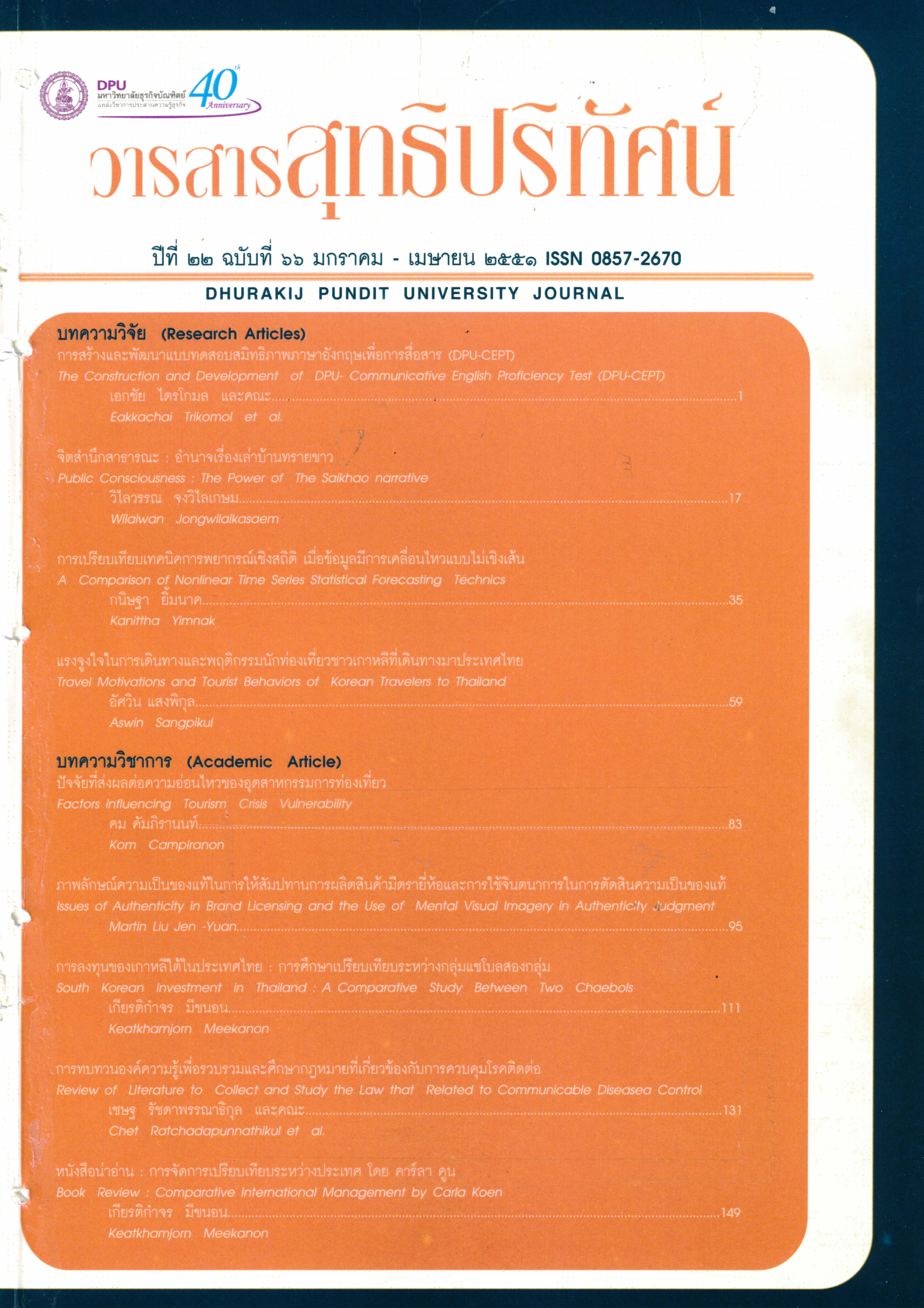การสร้างและพัฒนแบบทดสอบสมิทธิภาพภาษาอังกฤษเพื่อการสื่อสาร (DPU-CEPT)
คำสำคัญ:
การสร้างและพัฒนาแบบทดสอบ, แบบทดสอบสมิทธิภาพ, ภาษาอังกฤษเพื่อการสื่อสารบทคัดย่อ
แบบทดสอบ DPU - Communicative English Proficiency Test (DrU-CEPT) ถูกสร้างและพัฒนาขึ้นเพื่อการเรียนการสอนภาษาอังกฤษในระดับมหาวิทยาลัย แบบทดสอบ DPU-CEPT มีลักษณะคล้ายคลึงกับแบบทดสอบมาตรฐาน Test of English for International Communication (TOEIC) ซึ่งพัฒนาโดย Educational Testing Service (ETS) แบบทดสอบ DPU- CEPT ถูกสร้างให้เทียบเคียง (Equating) กับแบบทดสอบ TOEIC เพื่อการตีความคะแนนที่ง่ายขึ้น แบบทดสอบ DPU-CEPT มีค่าความเชื่อมั่น (KR-20 =.79) ในระดับที่ยอมรับได้ สหสัมพันธ์ระหว่าง DPU-CEPT และ TOEIC (r=.79) ยืนยันความตรงตามภาวะสันนิษฐาน (Construct validity) นอกจากนี้แบบทดสอบ DPU-CEPT ยังสัมพันธ์กับเกรดเฉลี่ยในภาคการศึกษาปัจจุบัน (GPA)(r=.71) และเกรดเฉลี่ยสะสม (GPAX) (r:.57) ซึ่งเป็นหลักฐานความตรงร่วมสมัย ด้วยคุณสมบัติเชิงจิตมิติที่น่าพึงพอใจ แบบทดสอบ DPU-CEPT จึงสามารถนำไปประยุกต์ใช้ในการเรียการสอนภาษาอังกฤษเป็นภาษาที่สองได้
References
American Educational Research Association, American Psychological Association, & National Council on Measurement in Education. (1999), Standards for educational psychological testing. Washington, D.C.: American Educational Association
Anastasi, A., & Urbina, S. (1997). Psychological testing. New Jersey: Prentice-Hall.
Center for Professional Assessment (Thailand). (2006). TOEIC examinee handbook. Bangkok, Thailand: Author.
Chauncey Group International. (2000). TOEIC Can-Do Guide: Linking TOEIC scores to activities performed using English. Princeton, NJ: Educational Testing Service.
Cohen, J, & Cohen, P. (1983). Applied multiple regression /correlation analysis for the behavioral sciences. NJ: Lawrence Erlbaum Associates.
Cronbach, L. J. (1989). Construct validation after thirty years. In R. L. Linn (Ed.), Intelligence, measurement, theory, and public policy: Proceedings of a symposium in honor of Lloyd G. Humphreys. Chicago: University of Illinois
Press.
Cronbach, L. J., & Meehl, P. E. (1955). Construct validity in psychological tests. Psychological Bulletin, 52, 281-302.
Educational Testing Service. (1998). TOEIC technical manual. Princeton, NJ: The Chauncey Group International.
Educational Testing Service. (2002). TOEIC examinee handbook. Princeton, NJ]: Author.
Educational Testing Service. (2007). TOEIC user guide. Princeton, N]: Author.
Gulliksen, H. (1950). Theory of mental tests. New York: Wiley.
Hughes, A. (1989). Testing for language teachers. Cambridge: Cambridge University Press.
Kuder, G. F., & Richardson, M. W. (1937). The theory of the estimation of the test reliability. Psychometrika, 2, 151-160.
Lord, F. M, & Novick, R. (1968). Statistical theories of mental test scores. MA: Addison-Wesley.
Nunnally, J. C. (Ed.). (1978). Psychometric theory (2nd ed.). New York: McGraw-Hill.
Nunnally, J. C., & Bernstein, I. H. (Eds.). (1994). Psychometric theory (2nd ed.). New York: McGraw-Hill.
Pedhazur, E. J. (1982). Multiple regression in behavioral research: Explanation and prediction. Holt, Rinehart and Winston.
Wilson, K. M. (1993a). Enhancing the interpretation of a norm-referenced second-language test through criterion referencing: A research assessment of experience in the TOEIC testing context. Princeton, NJ: Educational Testing
Service.
Wilson, K. M. (1993b). Validating a test designed to assess ESL proficiency at lower developmental levels. Princeton, NJ: Educational Testing Service.
Wilson, K. M. (1999). Validity of global self-ratings of ESL speaking proficiency based on an FSI/ILR-referenced scale. Princeton, NJ: Educational Testing Service.
Wilson, K. M. (2000). An exploratory dimensionality assessment of the TOEIC test. Princeton, NJ: Educational Testing Service.
Wilson, K. M., Komarakul Na Nagara, S, & Woodhead, R. (2004). TOEIC/LPI relationships in academic and employment contexts in Thailand. Princeton, NJ: Educational Testing Service.
Woodford, P. (1982). An introduction to TOEIC: The initial validity study. Princeton, NJ: Educational Testing Service.
Downloads
เผยแพร่แล้ว
How to Cite
ฉบับ
บท
License
เนื้อหาและข้อมูลในบทความที่ลงตีพิมพ์ในวารสารสุทธิปริทัศน์ ถือเป็นข้อคิดเห็นและความรับผิดชอบของผู้เขียนบทความโดยตรงซึ่งกองบรรณาธิการวารสาร ไม่จำเป็นต้องเห็นด้วย หรือร่วมรับผิดชอบใดๆ
บทความ ข้อมูล เนื้อหา รูปภาพ ฯลฯ ที่ได้รับการตีพิมพ์ในวารสารสุทธิปริทัศน์ ถือเป็นลิขสิทธิ์ของวารสารสุทธิปริทัศน์หากบุคคลหรือหน่วยงานใดต้องการนำทั้งหมดหรือส่วนหนึ่งส่วนใดไปเผยแพร่ต่อหรือเพื่อกระทำการใด ๆ จะต้องได้รับอนุญาตเป็นลายลักษณ์อักษรจากวารสารสุทธิปริทัศน์ก่อนเท่านั้น






